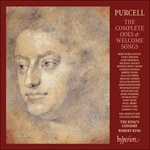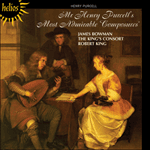
Welcome to Hyperion Records, a British classical label devoted to presenting high-quality recordings of music of all styles and from all periods from the twelfth century to the twenty-first.
Hyperion offers both CDs, and downloads in a number of formats. The site is also available in several languages.
Please use the dropdown buttons to set your preferred options, or use the checkbox to accept the defaults.

The fine opening Symphony is in the conventional two-section French style (which had itself originated in Italy), with the opening dotted section followed by a faster imitative triple-time movement. Two basses follow this with a rich duet, full of word-painting, linked to the first chorus by a short string ritornello. The section ‘Be lively then and gay’ is ingeniously based on the popular song ‘Hey boys, up go we’, and Purcell used its tune (to be found in The Dancing Master, 16th edition, 1686) first as the bass to the tenor solo, then as a counterpoint in the violins to the chorus, and then again as the bass to the dancing string ritornello which concludes the section. It is not known who was the bass singer for ‘In his just praise’ but he must have had a remarkable range of over two octaves which Purcell exploited to the full. The composer’s good humour continues, for in the next section the upper strings furiously play on all four of their open strings in response to the chorus’s exhortation ‘Tune all your strings’. The musical allegories continue in ‘From the rattling of drums and the trumpet’s loud sounds’ before we enter into a more gentle section ‘To music’s softer but yet kind and pleasing melody’ which is accompanied by two recorders. This leads into the jewel of the Ode ‘With him he brings’, sung at the first performance by the famous countertenor (and fine composer) William Turner. Over a wonderful four-bar ground bass the Queen’s beauty is praised, with especially delightful writing for ‘There beauty its whole artillery tries’, before the ground bass modulates up a fifth, and Purcell provides (as he does in so many of the Odes) a delicious string ritornello. The soprano duet ‘Happy in a mutual love’ which follows is delightful too, and the work ends with a lilting solo and elegantly harmonized chorus ‘Whilst in music and verse’.
from notes by Robert King © 2010
La belle Symphonie inaugurale adopte le style français conventionnel à deux parties (lui-même originaire d’Italie), avec la section liminaire pointée suivie d’un mouvement imitatif ternaire, plus rapide. Deux basses exécutent ensuite un riche duo, gorgé de figuralismes et rattaché au premier chœur par un bref ritornello de cordes. La section «Be lively then and gay» repose ingénieusement sur le chant populaire «Hey boys, up go we», dont Purcell utilisa la mélodie (trouvable dans The Dancing Master, 16e édition, 1686) d’abord comme basse du solo de ténor, puis comme contrepoint violonistique au chœur et, de nouveau, comme basse du dansant ritornello de cordes, qui clôt la section. On ignore qui assura la basse de «In his just praise», mais ce devait être un chanteur doué d’une formidable étendue de deux octaves passées, exploitée ici au maximum. Purcell ne se départit pas de sa bonne humeur et, dans la section suivante, les cordes supérieures jouent à une allure folle sur leurs quatre cordes à vide pour répondre à l’exhortation du chœur, «Tune all your strings». Les allégories musicales se poursuivent dans «From the rattling of drums and the trumpet’s loud sounds», avant une section plus paisible, «To music’s softer but yet kind and pleasing melody», accompagnée de deux flûtes à bec et débouchant sur le joyau de l’Ode, «With him he brings», chanté à la création par le célèbre contre-ténor (et bon compositeur) William Turner. Par-dessus un merveilleux ground bass de quatre mesures, la beauté de la reine est louée, avec une écriture fort charmante à «There beauty its whole artillery tries», puis le ground bass module à la quinte supérieure et Purcell nous concocte (comme il le fait si souvent dans ses Odes) un délicieux ritornello de cordes. Après le tout aussi ravissant duo de sopranos «Happy in a mutual love», l’œuvre s’achève sur un allant solo et sur un chœur élégamment harmonisé «Whilst in music and verse».
extrait des notes rédigées par Robert King © 2010
Français: Hypérion
Die wunderschöne einleitende Sinfonie steht im konventionellen zweiteiligen französischen Stil (der wiederum seinen Ursprung in Italien hatte), wobei dem ersten rhythmisch punktierten Abschnitt ein schnellerer imitativer Satz im Dreiertakt folgt. Zwei Bässe schließen sich mit einem prachtvollen Duett voller Wortmalerei an, das über ein kurzes Streicher-Ritornell mit dem ersten Chor verknüpft ist. Dem Abschnitt „Be lively then and gay“ liegt das populäre Lied „Hey boys, up go we“ zugrunde, das hier genial verarbeitet ist und dessen Melodie (die in der 16. Ausgabe von 1686 von The Dancing Master aufgeführt ist) Purcell erst als Bassbegleitung des Tenorsolos verwendet, dann als Kontrapunkt der Violinen zum Chor und dann noch einmal als Basslinie des tänzerischen Streicher-Ritornells, mit dem dieser Abschnitt beendet wird. Es ist nicht bekannt, wer die Basspartie von „In his just praise“ übernahm, doch muss er einen bemerkenswerten Stimmumfang von über zwei Oktaven gehabt haben, den Purcell voll ausnutzte. Der Komponist geht das Werk auch weiterhin mit Humor an, denn im nächsten Abschnitt spielen die hohen Streichinstrumente geschäftig ihre leeren Saiten, wenn der Chor sie dazu ermahnt, „alle Saiten zu stimmen“. Die musikalische Metaphorik setzt sich in „From the rattling of drums and the trumpet’s loud sounds“ fort, bevor es mit einem sanfteren Abschnitt „To music’s softer but yet kind and pleasing melody“ („Zu leiserer Musik, doch freundlicher und angenehmer Melodie“) weitergeht, der von zwei Blockflöten begleitet wird. Anschließend folgt das Prachtstück der Ode, „With him he brings“, das bei der Uraufführung von dem berühmten Countertenor (und großartigen Komponisten) William Turner gesungen wurde. Über einem wunderbaren viertaktigen Basso ostinato wird hier die Schönheit der Königin gepriesen, wobei „There beauty its whole artillery tries“ besonders reizvoll gestaltet ist. Dann wird der ostinate Bass eine Quinte nach oben moduliert und Purcell liefert (wie in so vielen seiner Oden) wiederum ein köstliches Streicher-Ritornell. Das anschließende Sopranduett „Happy in a mutual love“ ist ebenfalls reizend, und das Werk endet in einem beschwingten Solo und einem elegant harmonisierten Chor, „Whilst in music and verse“.
aus dem Begleittext von Robert King © 2010
Deutsch: Viola Scheffel
 Purcell: The Complete Odes & Welcome Songs Purcell: The Complete Odes & Welcome Songs‘A treasure house of shamefully neglected music. Over nine hours of wonderful invention … this major recording achievement must be an irresistibl ... ‘By any yardstick these are life-enhancing works’ (CDReview)» More |
 Purcell: Mr Henry Purcell's Most Admirable Composures Purcell: Mr Henry Purcell's Most Admirable Composures‘James Bowman must surely be the finest vocal interpreter of Purcell today. His grasp of sentiment, his sense of timing, and his enunciation, are unsu ...» More |

